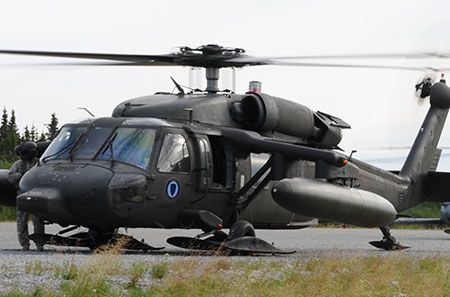Specialist Insights: Enhancing Efficiency in UH 60 Helicopter Operations
Specialist Insights: Enhancing Efficiency in UH 60 Helicopter Operations
Blog Article
Browsing Uh 60 Helicopter Rules and Conformity Demands

Regulatory Framework Overview
The regulatory structure regulating UH-60 helicopter operations encompasses a complex collection of requirements and guidelines established by aeronautics authorities. These guidelines are developed to guarantee the effective and safe procedure of UH-60 helicopters in different atmospheres. The Federal Aviation Management (FAA) plays a central duty in developing and imposing these regulations, which cover a vast variety of operational facets, including airworthiness criteria, pilot certifications, maintenance needs, and operational treatments.
Compliance with these laws is vital for helicopter operators to keep the highest degrees of safety and functional integrity. Failing to abide by these guidelines can result in severe consequences, consisting of accidents, injuries, and regulative sanctions. As a result, helicopter operators need to remain notified concerning the most recent governing developments and make sure that their procedures are in complete conformity with all appropriate regulations and standards.
Airworthiness Regulations and Inspections
Amidst the regulatory framework governing UH-60 helicopter operations, a vital emphasis pushes conformity with Airworthiness Directives and carrying out complete examinations to promote safety and security criteria and functional integrity. Airworthiness Regulations (Advertisements) are provided by air travel authorities to deal with hazardous conditions in aircraft, consisting of the UH-60 helicopter, and required certain actions to be taken by proprietors or drivers. Conformity with Advertisements is necessary, and failure to comply with these instructions can cause severe repercussions, including grounding of the airplane.
Routine inspections are vital to ensuring the airworthiness of UH-60 helicopters. By adhering to a rigorous evaluation routine, operators can spot and resolve prospective concerns quickly, consequently enhancing the security and integrity of UH-60 helicopter operations.
Pilot Certifications and Training

Pilot training for UH-60 helicopters is comprehensive and covers a vast array of subjects, including aircraft systems, emergency treatments, navigation, and mission-specific training. In addition, pilots undergo simulator training to exercise various emergency situation scenarios in a regulated setting. This training assists pilots create the required abilities to handle difficult scenarios efficiently.


Additionally, ongoing training and specialist description growth are necessary for UH-60 pilots to remain present with the most up to date regulations, technology, and ideal methods. By buying pilot qualifications and training, drivers can improve safety, optimize efficiency, and make certain conformity with governing requirements in the procedure of UH-60 helicopters.
Operational Limitations and Needs
Pilot credentials and training act as the structure for comprehending the operational limitations and needs connected with UH-60 helicopter operations (uh 60). These functional restrictions are implemented to make sure the safety and security of the staff, guests, and the aircraft itself. Operational limitations may consist of aspects such as weather problems, weight limitations, elevation restrictions, and functional boundaries. It is crucial for pilots to be fluent in these limitations to make enlightened decisions during trip operations. In addition, compliance demands, such as sticking to particular trip paths, interaction methods, and emergency treatments, are important for preserving functional safety and regulative conformity. Pilots have to stay current with all functional restrictions and demands via routine training, instructions, and assesses to reduce threats and ensure safe and effective UH-60 helicopter procedures. By prioritizing adherence to these operational standards, pilots can boost the overall safety and efficiency of their goals while upholding regulatory requirements.
Emergency Situation Treatments and Compliance Testing
Reliable emergency treatments and extensive conformity testing are critical elements of maintaining operational safety and regulative adherence in UH-60 helicopter procedures. Routine conformity testing makes sure that the helicopter meets all regulative requirements set forth by aeronautics authorities.
Compliance testing likewise reaches devices onboard the UH-60, such as interaction systems, navigating tools, and security equipment. Making certain that all equipment is operating appropriately and meets regulative standards is crucial for safe procedures. In addition, conformity testing may involve simulations of emergency circumstances to analyze the staff's feedback and the helicopter's efficiency under stress and anxiety. By prioritizing emergency situation procedures and conformity screening, UH-60 operators can reduce risks and demonstrate their commitment to security and governing conformity.
Conclusion
To conclude, adherence to regulatory framework, compliance with airworthiness directives, pilot qualifications and training, operational limitations, and emergency situation treatments are essential for browsing the laws and needs of running a UH-60 helicopter. uh 60. It is critical for drivers to focus on security and guarantee full compliance with all applicable laws to keep the airworthiness and functional stability of the aircraft
Navigating the governing landscape bordering UH-60 helicopter operations demands a nuanced understanding of the intricate internet of policies check here and compliance requirements.Conformity with these laws is necessary for helicopter operators to maintain the highest possible degrees of security and functional honesty.In the middle of the regulatory structure regulating UH-60 helicopter operations, a critical emphasis lies on conformity with Airworthiness Directives and carrying out extensive inspections to promote security standards and functional reliability.Reliable emergency treatments and extensive compliance screening are crucial parts of preserving functional security and governing adherence in UH-60 helicopter operations. Normal compliance screening guarantees that the helicopter fulfills all regulatory needs set forth by air why not check here travel authorities.
Report this page